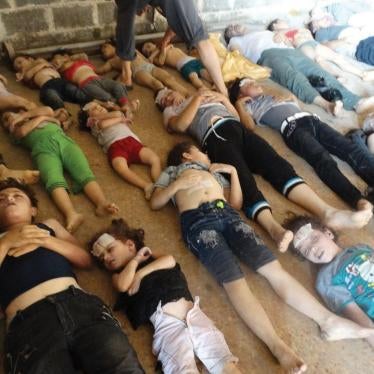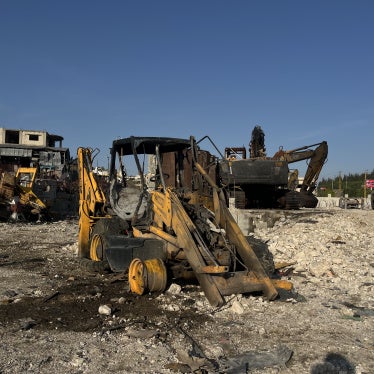(Washington, DC) – Syrian forces are using notoriously indiscriminate rockets that contain explosive submunitions. Evidence indicates that Syrian forces used BM-21 Grad multi-barrel rocket launchers to deliver cluster munitions in attacks near the city of Idlib in December 2012 and in Latamneh, a town northwest of Hama, on January 3, 2013.
These are the first known instances of Syrian use of ground-based cluster munitions. No information is available on how or when Syria acquired these cluster munitions, which were made in Egypt. Human Rights Watch and others have previously reported use of air-dropped cluster bombs. The Syrian government should immediately cease all use of cluster munitions, which have been comprehensively banned by 111 nations through an international treaty.
“Syria is escalating and expanding its use of cluster munitions, despite international condemnation of its embrace of this banned weapon,” said Steve Goose, director of the Arms division at Human Rights Watch. “It is now resorting to a notoriously indiscriminate type of cluster munition that gravely threatens civilian populations.”
Based on interviews with witnesses, analysis of approximately a dozen videos posted online by local activists, and photographs taken by an international journalist, Human Rights Watch has concluded that since at least early December Syrian forces have used BM-21 Grad multi-barrel rocket launchers to deliver 122mm cluster munition rockets containing submunitions of the DPICM-type (dual purpose improved conventional munition).
The attack using these cluster munitions on January 3 on Latamneh killed one civilian man and wounded 15 people, including women and children, while another civilian man was killed by an unexploded submunition left from the attack. Another man, a fighter for the armed opposition group the Free Syrian Army, was killed on December 5 after handling an unexploded submunition left from an attack two days earlier on the village of Banin in Jabal al-Zaweya.
The Soviet-made BM-21 multi-barrel rocket launcher is a truck-mounted system capable of firing 40 rockets nearly simultaneously. The rockets have a range from 4 to 40 kilometers and are notorious for their inability to be accurately targeted due to their lack of a guidance system. The inaccuracy of these rockets exacerbates the danger from the wide area effect of the submunitions they contain. Fired in groups, the rockets can inflict large-scale civilian casualties when used in residential areas, Human Rights Watch said.
The 122mm cluster munition rockets bear the markings of the Egyptian state-owned Arab Organization for Industrialization and an Egyptian company called Sakr Factory for Development Industries. The DPICM submunitions contained in the rockets are designed for both antipersonnel and antivehicle purposes. Each DPICM submunition is the size of a D cell battery and has a distinctive white ribbon. It is not known if the 122mm rockets are SAKR-18 or SAKR-36 variants, which contain 72 and 98 submunitions respectively.
These are the first recorded uses of the 122mm rockets containing DPICM submunitions in the Syrian conflict. In October and November, Human Rights Watch documented a country-wide increase in the use of Soviet-made RBK-250/275 AO-1SCh and RBK-250 PTAB-2.5 cluster bombs delivered by Syrian aircraft.
The LatamnehAttack
A resident of Latamneh described to Human Rights Watch the cluster munition strike on January 3 on his town, located northwest of Hama city:
Around 4 p.m., four rockets hit in Latamneh. It was raining a lot that day. It stopped and this was when we heard a very loud sound and then a big explosion. After that we heard a series of smaller explosions. The four rockets fell in different areas: three fell in the fields and the other one on the street between residential buildings.
One that exploded on the street next to a residential building caused a lot of damage. It killed two men and wounded 15 [including] women and children. Some were walking on the street at the time and others were in their house. Salah Mohammed Husain al Kharouf (around 45 years old) … was in his car driving when the bomblets exploded. He died instantly.
The resident told Human Rights Watch that al Kharouf was not a combatant. The resident said and graphic video footage shows that a 30-year-old man named Ala` Othman Zain, also identified as a civilian, was killed after the strike when he picked up a submunition that exploded in his hands. Video footage apparently shot in a local medical facility on the day of the strike shows a dead man with his right hand blown off and wounded civilians receiving treatment, including a baby, a young girl, boys, women, and men. One video shows a severe fragmentation wound on the baby’s right arm. Local residents said the people who were severely wounded were taken to Turkey for treatment, where they remain.
The resident visited one of the attack sites and told Human Rights Watch that he saw “bomblets spread out around 200 meters” including 20 unexploded submunitions. He took video footage that shows the remnants of a rocket and 10 explosive submunitions and said, “We took [the rocket and unexploded submunitions] with us back home. After we finished filming them we placed them in a bag and threw them away in the fields. They all exploded. It was the safest way to destroy them.”
The resident said that the Syrian Army has not been in Latamneh, but that the Free Syrian Army has been present since mid-December. The resident said that the town has been attacked by Syrian government planes and helicopters, but that the attack on January 3 was different because, “This was the first time this kind of rocket is used on us.” He said that the rockets were not dropped from an airplane: “There was no airplane that day. It was very foggy even after the rain stopped. The rocket came from the direction of Hama airport, located 40 km away from our town.”
Another resident told Human Rights Watch that Free Syrian Army (FSA) fighters in Latamneh told him that FSA fighters near Hama airport had informed them that the rockets were launched from the vicinity of the airport on January 3.
Another local resident described the January 3 attack to Human Rights Watch:
I heard a big explosion followed by smaller ones. It was still very cloudy but the rain stopped. After the explosions stopped I went to see what happened. The buildings that were hit were 200 meters away from the office. When I arrived I saw wounded people everywhere and small bombs covering the streets. The damage caused to the buildings was minimal. I saw a lot of unexploded bomblets. I don’t remember how many but more than 10.
The bomblets killed two men: one died instantly while he was in his car and the other one died an hour later when a bomblet exploded in his hands while he was trying to throw it far away from the yard of his house. His hand was amputated by the explosion. His name is Ala` Nasser Othman. The wounded [I saw] included seven children, five women and three men.
The resident said there was no FSA vehicle, office, or gathering near or at the buildings hit in the attack. He said that at the time of the cluster munition attack, clashes between the FSA and the Syrian army were taking place at the village of Bamourk, seven kilometers away.
Other videos uploaded to YouTube show remnants of the rocket and submunitions apparently used at Latamneh, including one video of a field pockmarked by small craters with several unexploded submunitions visible and another video showing unexploded submunitions in a residential area.
The December Attacks Near Idlib
On December 12, an international journalist visited an uninhabited forested area outside the village of Banin in Jabal al-Zaweya, where she photographed cluster munition remnants and the remnants of ground-launched rockets used in an attack on December 5. A local FSA representative informed the journalist that while no one was injured or killed during the cluster munition attack, an FSA member named Ahmed Mohamed Khalifa was killed on December 5 when he carried an unexploded submunition to his car. The damaged vehicle was still at the location of the incident when the journalist visited, with fragments of an exploded cluster submunition lodged in it. Khalifa was collecting unexploded submunitions with his brother to prevent civilians from handling them.
A number of videos filmed by local activists and uploaded to YouTube during December show remnants of the same type of ground-launched cluster munitions from locations within 20 kilometers of Idlib in Jabal al-Zaweya, including the towns of Sarja, Maa’rdebsa, Ma’arzaf, and Saraqeb.
Video footage shows people handling remnants of the 122mm rockets and unexploded DPICM submunitions, an extremely dangerous activity. The design of the fuze system in this type of submunition makes it very sensitive and submunitions that fail to explode on initial impact are liable to detonate if disturbed. The first Latamneh resident interviewed by Human Rights Watch said, “We distributed documents explaining to people not to touch the bomblets if they find one. We also reiterated this message during prayer time in mosques.”
More than 15 governments have condemned Syria’s use of cluster munitions, including Austria, Belgium, Denmark, France, Germany, Ireland, Japan, Mexico, Netherlands, New Zealand, Norway, Portugal, Qatar, Switzerland, the United Kingdom, and the United States.
A majority of the world’s nations have comprehensively banned the use of cluster munitions through the Convention on Cluster Munitions, which came into force on August 1, 2010. Syria is not a party to the convention and did not participate in the 2007-2008 Oslo Process that led to the creation of the treaty, which bans cluster munitions and requires clearance of contaminated areas and assistance to victims. A total of 77 states are party to the Convention on Cluster Munitions, while another 34 have signed but not yet ratified.
Human Rights Watch is a founding member of the international Cluster Munition Coalition, the civil society campaign behind the Convention on Cluster Munitions.




